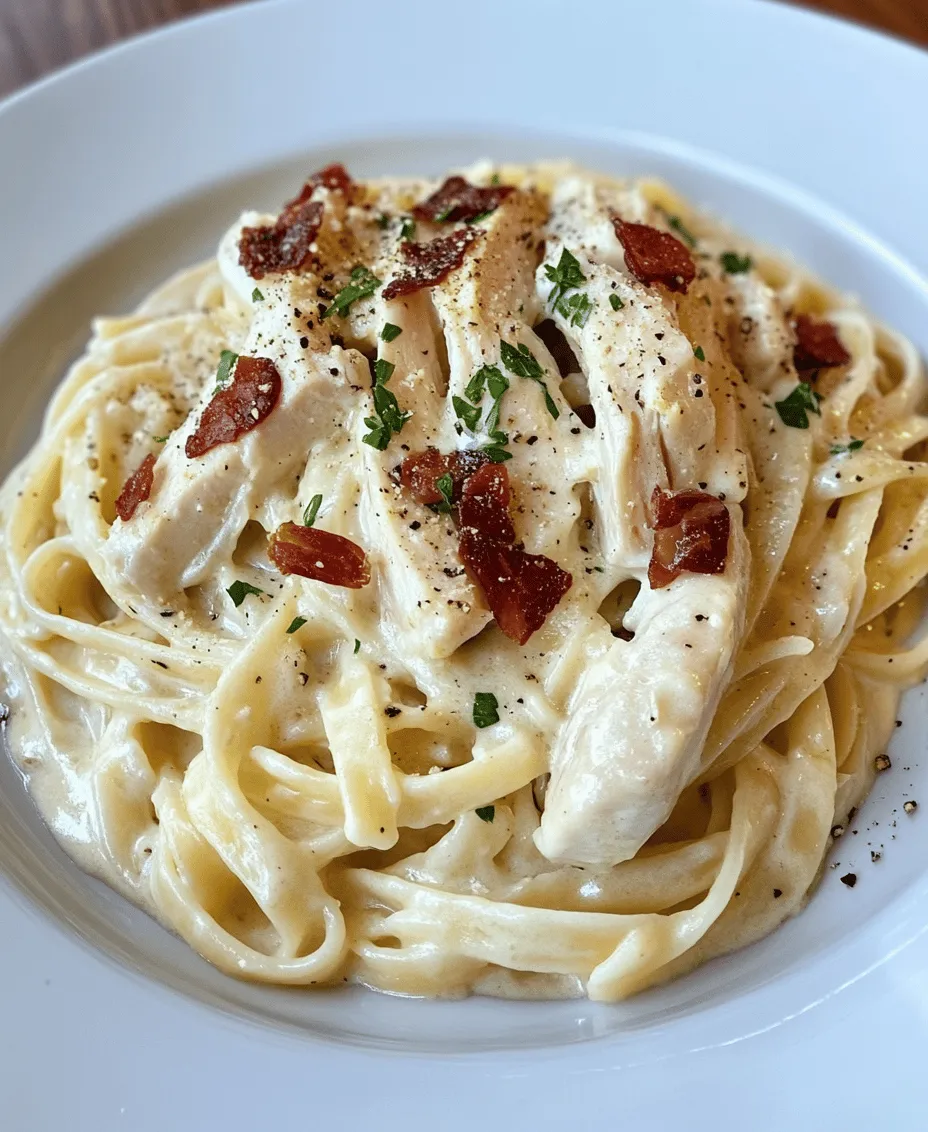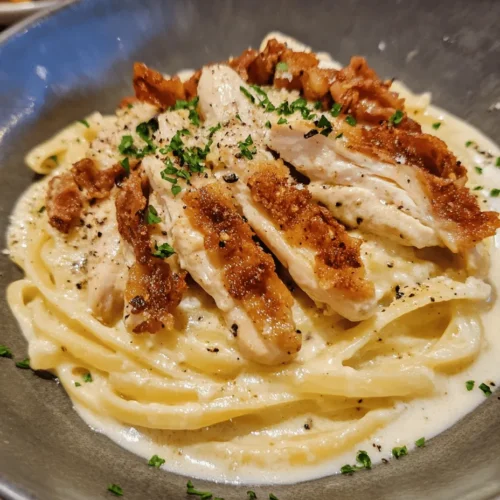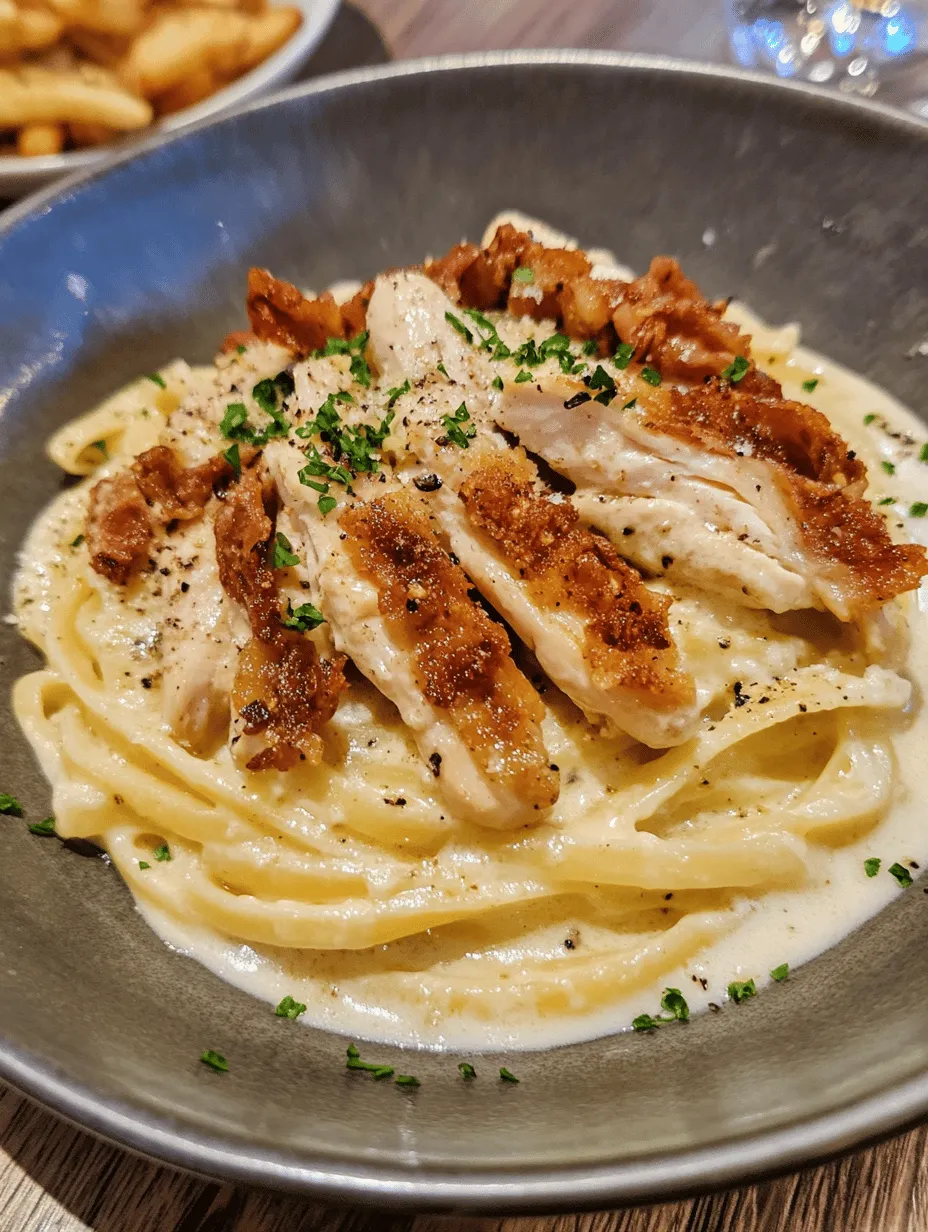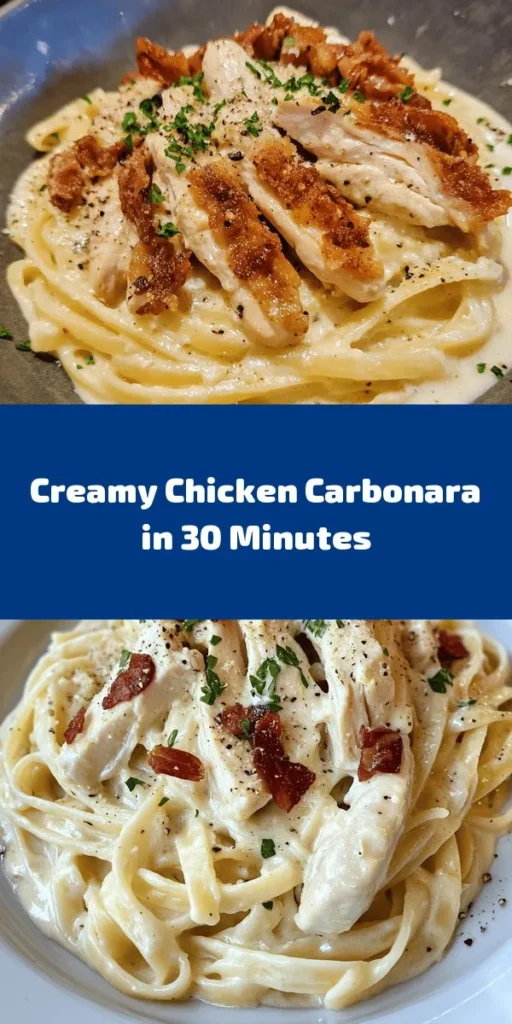Introduction
Chicken Carbonara is a delightful twist on the classic Italian dish that has captured the hearts and taste buds of food lovers around the world. Traditionally made with guanciale, Pecorino Romano cheese, and a silky egg sauce, Carbonara is known for its rich, creamy texture and robust flavors. This recipe takes a beloved comfort food and elevates it by incorporating tender chicken, making it a hearty and satisfying meal perfect for busy weeknights or cozy gatherings.
For home cooks seeking a quick yet delicious option that doesn’t compromise on flavor, this Best-Ever Chicken Carbonara is an ideal choice. It combines the classic elements of Carbonara with the added protein of chicken, ensuring that every bite is both indulgent and fulfilling. Whether you are familiar with making pasta dishes or are a novice in the kitchen, this recipe will guide you through each step to create a restaurant-quality dish at home.
Understanding Chicken Carbonara
Origin of Carbonara
The roots of Carbonara can be traced back to the mid-20th century in Italy, specifically to the region of Lazio. Although there are several theories regarding its origin, one popular belief is that it was created by charcoal workers (or “carbonari”) who would cook the pasta over a fire, using ingredients that were easy to transport. The simplicity of the dish, combined with its rich, savory flavors, quickly gained popularity, making it a staple in Italian cuisine.
Traditionally, Carbonara includes guanciale, a type of cured pork cheek, and is characterized by its creamy sauce made from eggs and cheese. Over the years, various adaptations have emerged, with some using bacon or pancetta in place of guanciale. This recipe embraces the spirit of Carbonara while adding the heartiness of chicken, making it accessible and appealing to a wider audience.
Traditional versus Modern Adaptations
While traditional Carbonara remains a beloved dish, modern adaptations have allowed for creative variations that cater to diverse tastes and dietary preferences. This Best-Ever Chicken Carbonara recipe stands out by maintaining the core elements of the original while infusing it with chicken for added protein and flavor. The use of boneless, skinless chicken breasts not only enhances the dish’s nutritional value but also provides a tender and juicy texture that complements the creamy sauce beautifully.
Additionally, the recipe adheres to the foundational principles of Carbonara—using high-quality ingredients and a careful cooking method to achieve the desired creamy consistency without the use of heavy cream. By incorporating chicken, this adaptation offers a satisfying and fulfilling meal that is perfect for family dinners or entertaining guests.
The Significance of Ingredients
In this Chicken Carbonara recipe, every ingredient plays a crucial role in creating the dish’s signature flavor profile and texture. The choice of ingredients is essential for achieving the authentic taste of Carbonara while enhancing its heartiness.
– Chicken: Using boneless, skinless chicken breasts adds a lean protein source that makes the dish more substantial without overwhelming the traditional flavors of Carbonara. Chicken pairs exceptionally well with the creamy sauce, ensuring that each bite is rich and satisfying.
– Pecorino Romano: A staple in authentic Carbonara, Pecorino Romano cheese brings a sharp, salty flavor that elevates the dish. Its unique taste is essential in balancing the richness of the egg sauce, making it a non-negotiable ingredient in this recipe.
– Pancetta or Bacon: The choice of pancetta or bacon introduces a salty, savory depth to the dish. Both options contribute a delightful crunch and richness that complements the creamy sauce, enhancing the overall flavor experience.
– Garlic: Garlic adds aromatic notes and a subtle kick, enhancing the overall depth of flavor in the dish. It infuses the oil used for cooking the chicken and adds a fragrant element that is hard to resist.
– Eggs and Cheese: The foundation of the creamy sauce, eggs and cheese combine to create a luscious texture that clings to the pasta beautifully. The heat from the pasta cooks the eggs gently, avoiding a scramble and resulting in a velvety sauce that is a hallmark of Carbonara.
– Fresh Parsley: Adding a sprinkle of fresh parsley at the end not only brightens the dish visually but also enhances the flavor with a fresh, herbaceous note. This final touch brings all the elements together, making the dish inviting and delicious.
Ingredients Breakdown
Key Ingredients and Their Roles in the Dish
1. Pasta (Fettuccine or Spaghetti): The choice between fettuccine and spaghetti is a matter of personal preference; both options are traditional for Carbonara. Fettuccine offers a broader surface area for the sauce to cling to, while spaghetti provides a classic, elegant presentation.
2. Chicken (Boneless, Skinless Breasts): Opting for boneless, skinless chicken breasts ensures that the dish is lean yet filling. Chicken cooks quickly and absorbs the flavors of the other ingredients, making it an excellent addition to this pasta dish.
3. Pancetta or Bacon: The inclusion of pancetta or bacon introduces a delightful crunch and savory richness. Pancetta is more traditional, while bacon adds a smoky flavor that many people enjoy.
4. Garlic: Fresh garlic is essential for enhancing the flavor of the chicken and adding aromatic qualities that elevate the dish’s overall taste.
5. Eggs: The eggs are crucial for creating the creamy sauce that binds the dish together. They should be at room temperature to ensure they blend smoothly with the hot pasta.
6. Pecorino Romano Cheese: This cheese is a key ingredient in traditional Carbonara, providing a sharp, salty flavor that balances the richness of the sauce.
7. Fresh Parsley: A sprinkle of fresh parsley not only adds a pop of color but also brings a fresh taste that lightens the richness of the Carbonara.
Step-by-Step Cooking Instructions
Detailed Cooking Process for Clarity and Ease
Now that we’ve explored the background and significance of the ingredients, let’s move on to the cooking process. This recipe is straightforward and designed to be completed in about 30 minutes, making it perfect for a busy weeknight dinner.
1. Prepare the Ingredients:
– Start by gathering all your ingredients and measuring them out. Having everything ready to go will streamline the cooking process.
– Chop the chicken into bite-sized pieces, dice the pancetta or bacon, and mince the garlic.
2. Cook the Pasta:
– Fill a large pot with water and bring it to a boil. Add a generous pinch of salt to enhance the flavor of the pasta.
– Once the water is boiling, add the fettuccine or spaghetti and cook according to package instructions until al dente. Remember, the pasta should have a slight bite to it as it will continue to cook when mixed with the sauce.
3. Sauté the Chicken and Pancetta:
– While the pasta cooks, heat a large skillet over medium heat. Add a drizzle of olive oil and allow it to heat up.
– Add the diced pancetta or bacon to the skillet and cook until it becomes crispy, about 4-5 minutes.
– Remove the pancetta from the skillet and set it aside, leaving the rendered fat in the pan.
– Add the chicken to the skillet, season it with salt and pepper, and sauté until it is cooked through and golden brown, approximately 5-7 minutes. Incorporate the minced garlic in the last minute of cooking to prevent it from burning.
4. Combine Pasta and Sauce:
– Once the pasta is cooked, reserve a cup of pasta water and then drain the rest.
– Add the hot pasta directly into the skillet with the chicken and pancetta. Toss everything together to combine.
– Remove the skillet from heat and quickly add the beaten eggs and grated Pecorino Romano cheese, stirring vigorously to create a creamy sauce. If the sauce seems too thick, gradually add reserved pasta water until the desired consistency is achieved.
5. Finish and Serve:
– Once the sauce has reached a silky consistency, stir in the freshly chopped parsley for added color and freshness.
– Serve immediately, garnished with additional Pecorino Romano cheese and a sprinkle of black pepper, if desired.
By following these steps, you’ll create a delectable Chicken Carbonara that captures the essence of the traditional dish while offering a satisfying and hearty meal perfect for any occasion. Stay tuned for part two, where we will delve into additional tips for achieving the best results and answer some common questions about making this dish!

Preparing the Chicken: Tips for Achieving Perfect Browning
For the best-ever Chicken Carbonara, achieving perfectly browned chicken is crucial for flavor. Start by selecting chicken breasts that are even in thickness, ensuring they cook uniformly. Before cooking, pat the chicken dry with paper towels—this step removes excess moisture and promotes browning. Season the chicken generously with salt and pepper to enhance the natural flavors.
Heat a large skillet over medium-high heat and add a splash of olive oil. Once the oil is shimmering, gently place the chicken in the pan. Avoid overcrowding the skillet; this can lead to steaming rather than searing. Cook for about 5-7 minutes on each side, depending on the thickness of your chicken. Look for a golden-brown crust before flipping. To ensure the chicken is cooked through, use a meat thermometer; the internal temperature should reach 165°F (75°C). Once cooked, remove the chicken from the skillet and allow it to rest before slicing. This resting period allows the juices to redistribute, keeping the meat tender and juicy.
Cooking the Pancetta or Bacon: How to Achieve the Right Level of Crispiness
Pancetta or bacon adds a rich, savory flavor to your Chicken Carbonara. To achieve the perfect crispiness, choose high-quality pancetta or thick-cut bacon. Begin by slicing the meat into small pieces and adding it to a cold skillet. This method allows the fat to render slowly, resulting in perfectly crispy bits.
Turn the heat to medium and cook until the pancetta or bacon is golden and crispy, stirring occasionally to ensure even cooking. This process typically takes about 5-10 minutes. Once crispy, use a slotted spoon to transfer the cooked pancetta or bacon to a plate lined with paper towels, which will absorb any excess grease. Reserve a tablespoon of the rendered fat in the skillet, as it will add an extra layer of flavor to your sauce.
Combining Ingredients: Techniques for Perfect Integration of Flavors
Combining the ingredients in your Chicken Carbonara is where the magic happens. Begin by slicing the rested chicken into bite-sized pieces. In the same skillet used for the pancetta, add the cooked chicken and toss to coat it with the rendered fat. This step infuses the chicken with the smoky flavor of the pancetta.
Next, add the cooked pasta directly to the skillet. It’s essential to reserve a cup of pasta water before draining, as this starchy liquid helps bind the sauce to the pasta. Using tongs, gently toss the pasta with the chicken and pancetta, ensuring everything is evenly distributed. If the mixture appears dry, gradually add some of the reserved pasta water until you achieve the desired consistency.
Making the Creamy Sauce: Whisking Tips and Achieving the Right Consistency
The creamy sauce is the heart of Chicken Carbonara, and making it requires a bit of technique. In a mixing bowl, whisk together fresh eggs, grated Pecorino Romano cheese, and freshly cracked black pepper until well combined. The heat from the pasta will gently cook the eggs, creating a creamy sauce without scrambling them.
Once the pasta is well mixed with the chicken and pancetta, remove the skillet from the heat. Quickly pour the egg mixture over the pasta, stirring vigorously to combine. The residual heat from the pasta will cook the eggs and create a silky sauce. If the sauce is too thick, add more reserved pasta water a little at a time until you reach the desired creaminess.
Flavor Enhancements and Variations
Suggestions for Adding Vegetables: Peas or Spinach for Added Nutrition
Enhancing your Chicken Carbonara with vegetables not only boosts nutritional value but also adds color and flavor. Fresh or frozen peas are a popular addition; simply sprinkle them over the pasta just before combining with the sauce. Alternatively, baby spinach can be added for a vibrant touch. Toss it in just until wilted, ensuring it retains its bright green color and nutrient content.
Alternative Proteins: Substituting Chicken with Shrimp or Mushrooms
If you’re looking to switch up the protein in your Chicken Carbonara, consider using shrimp or mushrooms. For shrimp, use large, peeled, and deveined varieties. Sauté them in the skillet for about 2-3 minutes per side until they are opaque and cooked through. If opting for mushrooms, choose varieties like cremini or shiitake for an earthy flavor. Sauté them until golden before adding to the pasta.
Cheese Alternatives: How to Use Parmesan or Other Cheeses
While Pecorino Romano is traditional, you can substitute it with Parmesan if preferred. Parmesan offers a milder flavor but still contributes creaminess to your sauce. For a unique twist, consider using a blend of cheeses like Gruyère or Fontina for added depth.
Spice It Up: Incorporating Red Pepper Flakes or Herbs
For those who enjoy a little heat, adding red pepper flakes to the sauce is an excellent way to spice things up. Start with a pinch and adjust to your taste. Fresh herbs like parsley or basil can also enhance the dish’s freshness. Sprinkle them on top just before serving for a burst of flavor.
Serving Suggestions
Ideal Side Dishes to Complement Chicken Carbonara
Chicken Carbonara pairs beautifully with a variety of side dishes that enhance its flavors. A simple arugula salad dressed with lemon vinaigrette provides a refreshing contrast to the richness of the pasta. Garlic bread or toasted baguette slices are perfect for mopping up any leftover sauce. For something heartier, consider serving steamed asparagus or roasted Brussels sprouts.
Presentation Tips for an Appealing Plate
Presentation is key when serving Chicken Carbonara. Use a large pasta bowl or shallow plate for a dramatic effect. Twirl the pasta into a nest shape for an elegant look. Finish with a generous sprinkle of freshly grated cheese, a dash of black pepper, and a few fresh herbs for color. A drizzle of high-quality olive oil can also elevate the presentation.
Pairing with Wines: Recommendations for a Perfect Match
To complement the flavors of Chicken Carbonara, consider pairing it with a light white wine such as Pinot Grigio or Sauvignon Blanc. These wines have enough acidity to cut through the richness of the dish. If you prefer red wine, a light-bodied option like Chianti can work well, providing a nice balance without overpowering the meal.
Nutritional Information
Breakdown of Calories, Protein, and Other Key Nutrients Per Serving
A serving of Chicken Carbonara provides a hearty meal packed with flavor. On average, one serving (about 1 cup) contains approximately 600-700 calories, depending on the specific ingredients used. It offers around 35 grams of protein, making it a filling option. Additionally, the dish contains essential nutrients like calcium from the cheese and protein from the chicken.
Discussion on the Balance of Indulgence and Health in This Recipe
While Chicken Carbonara is indulgent, it can also be made healthier by incorporating whole-grain pasta or adding more vegetables. The beauty of this recipe lies in its versatility; you can enjoy it as a comforting classic or adapt it to fit your nutritional needs without sacrificing flavor.
Conclusion
Making Chicken Carbonara at home is a rewarding culinary experience that brings comfort and joy to any table. This creamy, savory dish is not only delicious but also allows for creativity and experimentation. Don’t hesitate to try different proteins, add vegetables, or adjust the flavors to your liking.
As you master this recipe, remember that sharing it with family and friends enhances the experience. Enjoy the process, savor the flavors, and relish the time spent around the dinner table. Your best-ever Chicken Carbonara will surely become a beloved dish in your household, perfect for any occasion.



